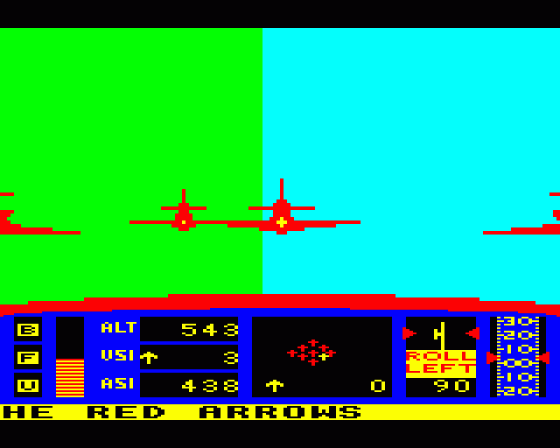

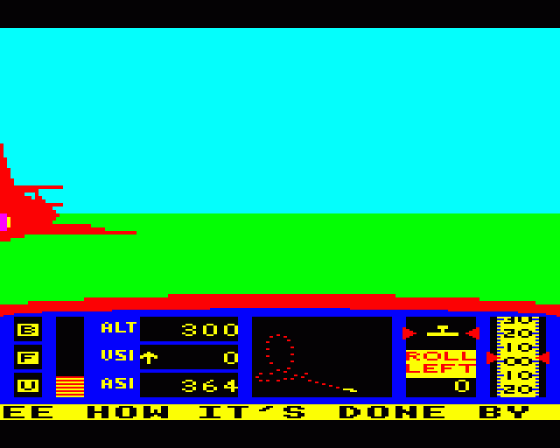


| Genre: | Game: Flight Simulator |
| Publisher: | Database |
| Cover Art Language: | English |
| Machine Compatibility: | BBC Model B |
| Release: | Professionally released on 5.25" Disc |
| Available For: | Amstrad CPC464, BBC Model B, Commodore 64/128 & Spectrum 48K |
| Compatible Emulators: | BeebEm (PC (Windows)) PcBBC (PC (MS-DOS)) Model B Emulator (PC (Windows)) |
| Original Release Date: | 20th June 1986 |
| Original Release Price: | Unknown |
| Market Valuation: | £4.00 (How Is This Calculated?) |
| Item Weight: | 64g |
| Box Type: | 5.25" Disc(s) Plastic |
| Author(s): | Christopher Price |
Variant Items
There are 2 other items featuring this same game (that we know about!). Click any of them for their details.
Active Auctions
Closed Auctions
Buy It
Unfortunately no-one is currently selling this item.
Auction Price Watch
Worried you're being ripped off? Closing prices on eBay can help you decide what a reasonable price is for a particular item.

A&B Computing
1st February 1986
I was not impressed with the playability... It's so difficult I could not perform a manoeuvre properly. Read Review

Acorn User
1st April 1986
A very clever, very demanding flight simulation. Read Review

Computer & Video Games
1st May 1986
Should keep the dedicated flight simulation enthusiast absorbed. Read Review

Computer & Video Games
1st October 1985
The actual graphic representation of the Red Arrows, on the Spectrum version is awful. I don't think even the prospect of a day out with the Arrows would make me want to shell out nearly £9 for this game. Read Review
Full Instructions
Red Arrows
Now you can fly with the legendary Red Arrows - in the most challenging flight simulation ever!
It's the most exciting, full colour flight simulator ever written for the home computer - and it uses every ounce of the micro's power to give the utmost realism to recreating the most spectacular aeronautical displays that have thrilled crowds at air shows for the last 21 years. The program comes with a detailed flight handbook that will soon help you take your place alongside the ace pilots of the Red Arrows!
History of Aerobatics
In the comparatively short history of aviation, formation aerobatics has developed from groups of individual biplanes flying together into the mirror-image team performances of advanced jet aircraft, as exemplified by The Red Arrows.
Only 63 years ago five SE5As of the Royal Aircraft Establishment introduced the first formation spin to amaze the public.
Innovations and experiments followed rapidly as different aircraft were designed and new pilots came along to attempt previously untried manoeuvres.
In 1926 nine Gloster Grebes of No. 25 Squadron flew in sections of three, while the public listened to the leader's commands broadcast over loudspeakers.
A year later No. 41 Squadron's team taxied off to give their display to music. It was Siskins belonging to No. 43 Squadron that flew past the crowds in 1930 with their wings linked by breakable cord.
By then smoke, special paint schemes and synchro pair manoeuvres had all made their debuts - adding to the interest and excitement of many air shows.
The paint markings on the upper wings of Gypsy Moths were essential for the public to tell when these pioneering aircraft were inverted!
In comparison with aerobatics today, the displays were extemely simple, with No. 25 Squadron's three Hawker Furies being among the first to introduce formation changes in 1935. They were also the first team to display abroad.
It may seem incredible to the generation brought up on the speed and spectacle of The Red Arrows, but there was considerable pessimism after the second world war over the suitability of jet aircraft for formation aerobatics.
However in 1947 the first Royal Air Force team of three Vampires was formed from the Odiham Fighter Wing. The following year a team from No. 54 Squadron visited the USA and Canada.
The success of the Vampire ensured the rapid return of formation aerobatics to the top of the attraction stakes at air shows, and they dominated the scene until 1950, when the Gloster Meteor rose to become acclaimed as the ideal aerobatic aircraft. This in turn was supplanted by the Hawker Hunter.
Treble One Squadron (No. 111) in particular was associated with the Hunter, especially once they had become the premier team of the Royal Air Force in 1957, flying their famous all-black aircraft.
It was the French who first described this team as "The Black Arrows", and they later also became known as "the fathers of modern formation aerobatics".
They inspired a completely new approach to display work, devising practical patterns in the sky that were complimentary to the swept back shape of the new jets, rather than trying to re-create pre-war formations intended for box-wing aircraft.
All this time aerobatics was only a secondary occupation for fighter squadrons and few teams were together for very long.
However The Black Arrows maintained their position as the premier team until 1961, and this continuity clearly enabled the pilots to produce an integrated, polished performance, where many machines operated as one.
They are probably best remembered for their 22 Hunter formation loop, flown in 1958 for the first time in history.
The Blue Diamonds, who succeeded The Black Arrows in 1961, further developed the aerobatic professionalism of the Royal Air Force (although still secondary to their operational role) with the division of their 16-ship team into two, so that there was always a formation "on stage' in front of the crowd.
In 1963 the last operational Royal Air Force team on nine Lightnings, The Firebirds, took to the air. From then on teams were to be drawn by selection from training units since it was no longer possible to justify the expense of maintaining fighter squadrons with this extra work load.
The Central Flying School, an obvious contender to produce a team, came up with The Red Pelicans in 1964. These six Hunting Jet Provosts turned out to be a far from inspiring sight after the speed and thunder of the Hunters and Lightnings.
However at the Society of British Aircraft Companies show at Farnborough that year the Central Flying School decided to fly a second aerobatic team as well. This was made up of five Hawker Siddeley Gnats from No. 4 Flying Training School at Valley, led by Flight Lieutenant Jones, and known by their call sign, The Yellowjacks.
The combination of this man and this aircraft proved to be a catalyst in the development of formation aerobatics within the Royal Air Force.
Arrival Of The Hawk
Project Hawk began in the late 1960s. The original concept was that of an advanced weapons jet trainer to replace several types of aircraft in use, and also the possible employment in front line combat roles. Its very large warload, radius of action and loiter time capabilities made it a highly potent aircraft, capable of surviving in tomorrow's hostile environment.
In the training role the Hawk was to meet the demand of the Royal Air Force to replace several different types in use. Before the Hawk entered service with the Royal Air Force in 1976 the jet training task required three different types of aircraft – the Jet Provost for basic training, the Gnat for advanced flying training and the Hunter for weapons instruction.
The Hawk's performance after introduction was so successful that it ailowed the withdrawal of the Gnat and Hunter fleets from Advanced Flying Schools one year earlier than planned.
The Hawk embodies all the skill and experience that British Aerospace has developed over many decades in designing and producing high performance military aircraft and has met all the Royal Air Force's uncompromising requirements for performance and economy of operation.
A rugged structure enables it to carry ordnance exceeding 6,500lb - more warload than any aircraft in its class. Its low level performance ensures penetration and escape from hostile defence systems.
The Hawk can also fulfil an effective role as a secondary air defence fighter, armed with a combination of Aden 30mm gun, wing-mounted and centre pylon air-to-air and long range sea-skimming anti-ship missiles. Its exceptional manoeuvreability, good climb rate, quick reaction time and long endurance enable it to provide effective air defence at low and medium levels.
Deliveries of the Hawk T. Mk1 began in November 1976 to No. 4 Advanced Flying Training School, part of RAF Support Command, at RAF Valley, and late in 1977 to Tactical Weapons Unit at RAF Brawdy in South Wales which is an integral part of RAF Strike Command.
The Red Arrows received their 11 red Hawks in November 1979 and were able to start the 1980 season with aircraft that were to break all records.
Aerobatics And Manoeuvres
In the very early days of aviation, at the turn of this century, aircraft merely defied gravity – a momentuous enough achievement. Yet in no time at all increased mechanical manoeuvreability and growing pilot expertise produced the first arobatics, loops, circles, dives and spins.
Formation aerobatics came with the developing aircraft industry since like minded individuals of a dare-devil disposition were then presented with identical models with which to demonstrate their combined skills.
The early Royal Air Force recognised there was far more to it than pure exhibitionism, and included aerobatics in pilot training from the start. It is now regarded as an essential step in giving a pilot complete confidence in himself and his aircraft. From this formation aerobatics naturally follows, instilling into each individual the added factor of confidence in his leader and other team members.
One topic that was ever present in the minds of the Red Arrow's pilots during the 1979 season was the change over to the British Aerospace Hawk, the Royal Air Force's replacement for the Gnat which for over 15 years had flown almost 1,300 venues.
The Red Arrows' first display with the Hawk was at Seywell on April 6, 1980 at the start of a successful season of 119 performances. All the excellent flying qualities of the Hawk come together at their best in aerobatics. The Hawk is truly a pilot's aircraft, combining precise and responsive control with great agility, good natural stall warning, freedom from sudden departure, unrestricted engine handling throughout the normal flight envelope and superb view.
It is cleared for operation between 8g and -4g and is remarkable for its low induced drag, permitting sustained level turns of 6g at 450 knots at low altitude, and prolonged turns at 8g with only modest rates of descent or speed loss.
 |
Flying With The Red Arrows
Red Arrows is a flight simulator based on the Hawk and the formation flying of the Red Arrows. For most people it is the closest that they will come to the fun and excitement of flying with the nine man team.
Red Arrows consists of two separate programs. The first offers the chance to practice individual manoeuvres, while the second gives you the chance to fly in a display as suggested by the Red Arrow pilots.
The controls and instruments are described later, but it should be noted that during formation flying, apart from Red Leader, the Red Arrows make very little reference to the instruments. This does not mean that this flight simulator is a simple case of follow the leader. You must keep exactly in formation or your rating at the end will be poor.
You will need to accelerate rapidly near the top of loops as Red Leader goes over the top and is on his way down before you reach the top (see the Hints section on Page 16). You will have the problem of keeping up when you are flying on the outside of a circle with Red Leader setting the pace from a smaller circle. .
You will encounter these, and many more difficulties, as you try to keep your exact position in the formation.
 |
| Dimensions | ||
| Length | 11.85m | 38ft 11in |
| Wing span | 9.39m | 30ft 10in |
| Height | 4.00m | 13ft 2in |
| Wing area | 16.689m.sq. | 179.64ft.sq |
| Performance | ||
| Max. dive speed (at altitude) | Mach 1.2 | |
| Max. level speed | 1040km/hr | 560kt |
| Max. altitude | 15240m | 50000ft |
| Max. warload | 3100kg | 6800lb |
| Weights | ||
| Empty weight (no fuel, no crew) | 3635kg | 8013lb |
| Max. take-off weight | 8400kg | 18520lb |
| Fuel Capacity | ||
| Internal | 1705 litres | 375 Imp gal |
| External (max.) | 1725 litres | 380 lmp gal |
| Powerplant | ||
| Rolls-Royce Adour | ||
| turbofan. Max. sea | ||
| level static thrust | 25.4kN | 5700lb |
Instruments
 |
-
BRAKE WARNING LIGHT
Shows red if the brakes are on. Note that the brakes can be applied to varying degrees, and this light shows if the brakes are on even slightly. Note that in the air the brakes are the air brakes and on the ground they are the wheel brakes. -
FLAPS WARNING LIGHT
Lets you know if the flaps are up or down (red is up). -
UNDERCARRIAGE WARNING LIGHT
Gives you the state of the undercarriage (red is down). -
THRUST BAR
Tells you the thrust of the engines. -
5
(a) ASI... Air speed indicator shows your air speed.
(b) VSI. . Vertical speed indicator shows your speed of ascent or descent (the arrow indicates up or down).
(c) ALT.. Altimeter shows your altitude. -
MULTI-SCREEN
You can select:
(a) FORMATION/RADAR... Shows your position relative to the rest of the squadron (needed if you loose them and cannot see them through the cockpit). If you are close to the squadron, your position in the formation can be determined. The number printed at the bottom indicates your vertical height difference with the rest of the squadron.
(b) VIEW ... Shows a picture of your manoeuvre. -
ARTIFICIAL HORIZON
Gives you a picture and digital readout of the bank of the aircraft. -
ROLL BAR
Shows the inclination of the aircraft. The bar changes colour as you go over 90 degrees. -
MESSAGES
Messages from Red Leader will scroll across here.
Controls
All the controls may be activated from the keyboard and can be chosen by the pilot at the start of the game. If you prefer not to choose your own keys the default keys for your computer will be shown as you load the program.
If you prefer to use joysticks, eight functions can be obtained. These are: Without "FIRE" pressed –
FORWARD and BACK - Elevators
LEFT and RIGHT - Ailerons
With "FIRE" pressed:
FORWARD and BACK - Thrust
LEFT and RIGHT - Brakes
The following diagrams will make the joystick functions more clear:
Without "FIRE": Push nose
 |
With "FIRE'':
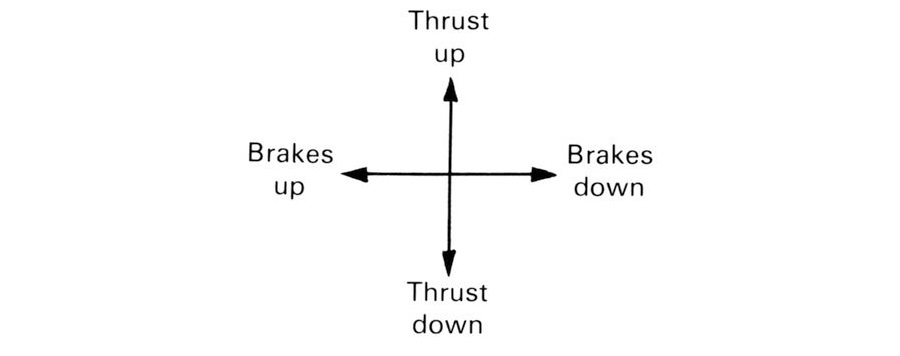 |
Whether you are using keyboard or joystick, you will need to select keys to use for the following: .THRUST-BRAKES... for some manoeuvres "the Red Arrows fly with the brakes on. This button builds thrust against brakes so that you continue with the same overall thrust. Using a brake or thrust control switches this effect off. See the Hints page for the need for this feature.
FLAPS
One key toggles the flaps up and down.
UNDERCARRIAGE
Another one key toggle.
RUDDER
The Red Arrows rarely use this, so no display of amount of rudder is provided. You need to select three keys - one for left, one for right and one to centralise the rudder.
Playing Hints
- Red Leader is often flying at over 90 per cent thrust. For many manoeuvres, you will need more.
- Thrust is slow to build up. For more instant thrust, build the brakes against the thrust, so that as the brakes are released instant thrust is obtained.
- Follow the plane(s) formation in front, keeping yourself in the position shown in the diagrams on Pages 20 and 21.
- To change formation, fast acceleration or deceleration may be needed (see hint 2).
- Most manoeuvres take place at heights of between 250 and 5000 feet.
- The typical speed at the bottom of a loop is 350 knots.
- If you are not sure how to move from one formation to another, remember that as RED 8 you are mirroring the movements of RED 9. Watch what he is doing in the multi-screen display.
- If you stall the Hawk, the plane's automatic stall recovery system will try to recover you.
- If no option is selected from the menu, after a short while the program will enter the demonstration mode. This gives you the ideal chance to watch how you should be flying.
The Manoeuvres
With the first program you can practice any of the manoeuvres illustrated on Pages 18 and 19 by selecting the appropriate one from a menu. On the second program you will be expected to fly the full display.
As you do the display, messages from Red Leader will scroll across the bottom of the screen. Each will be followed by the word GO, which is the signal to move into a new formation. Two numbers will follow, which is the acknowledgement from the team.
You will be expected to follow the formations as RED 8. Study them well and get plenty of practice using the practice program.
Then when you feel you have acquired the required skills on each manoeuvre try to keep with the team in a perfect display.
 |
The Formations
As you perform the manoeuvres illustrated, you will see commands for formation changes scroll across the display panel. At the command GO, follow position 8 (shown as ) into the next formation, as shown below. You will see the team acknowledge the order (by giving the figures in brackets).
 |
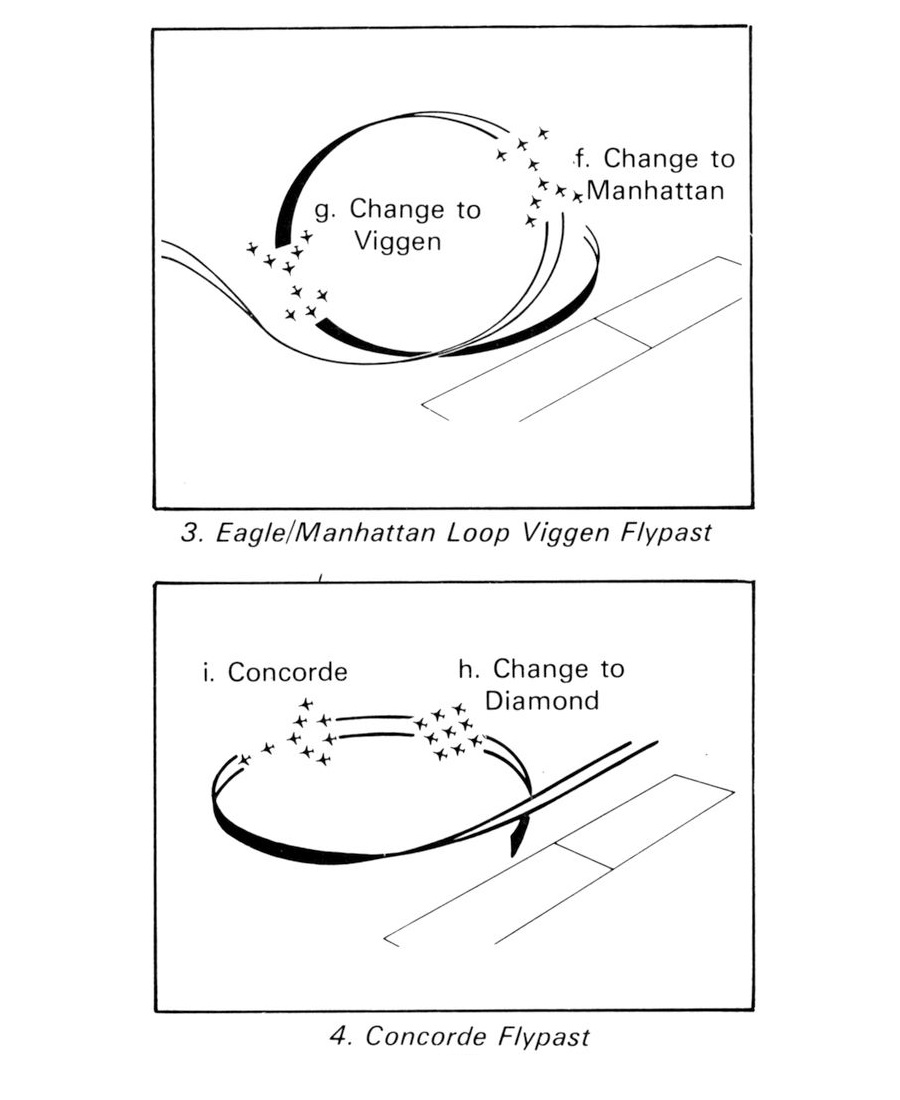 |
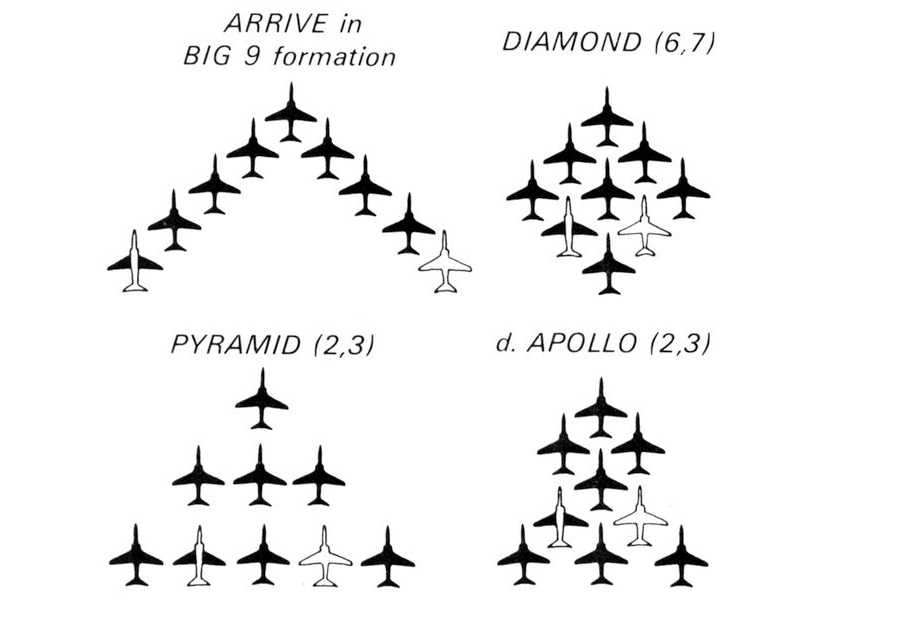 |
 |
 |
Loading
Tape: CHAIN"" (RETURN)
Disc: SHIFT-BREAK
Miscellaneous
This game was mentioned in the following articles:
Screen Designers
The following utilities are also available to allow you to edit the supplied screens of this game:
Cheats
Download
A digital version of this item can be downloaded right here at Everygamegoing (All our downloads are in .zip format).
| Download | What It Contains |
|---|---|
| A digital version of Red Arrows suitable for BeebEm (PC (Windows)), PcBBC (PC (MS-DOS)), Model B Emulator (PC (Windows)) |
Report A Problem
We thank you from the bottom of our hearts if you report something wrong on our site. It's the only way we can fix any problems!
You are not currently logged in so your report will be anonymous.
Add Note
Release Country
Change the country to update it. Click outside of this pop-up to cancel.
Scan Of Selected Article
If you auction an item, it will no longer show in the regular shop section of the site.











